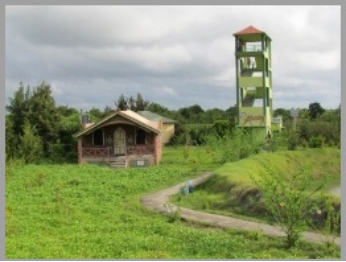BONNIE CAMP|BONNIE CAMP WATCH TOWER|SUNDARIKATHI ECO CONSERVATION CAMP
The original name of the camp was Sundarikati Eco Conservation Camp. On 15th July 2003, Shri Budhhadeb Guha, a famous novelist renamed the camp as Bonnie Camp.
Like all other camps in Sundarbans, this enclosed area consists of a Eco Museum just below the Watch Tower, a Banbibi temple, a few ethnic cottages with night stay option, a round-shaped lodge cum dormitory as well as a tall watchtower. This watchtower, 50 feet high, is the highest watchtower in the Sundarbans. An added attraction of the park is a deer enclosure. where one can see numerous deer moving around the enclosure.
Other than the watchtower, the camp has a beautiful and well maintained park, artificial bridge over a small pond and the administrative office as well as the staff quarters. There is also a sweet-water pond and a few observation lines where the wildlife of Sundarbans frequent throughout the day. Bonnie Camp, is one of the most beautiful watchtowers in the Sundarbans. It is quite close to the Bay of Bengal and generally takes around 06 hrs to reach from Sajnekhali by a six cylinder boat .
The ambiance of the watchtower is absolutely fabulous and one gets the feeling of being marooned on a desolate island when one spends the night at Bonnie camp. The lurking fear of the Royal Bengal Tiger and the barking of the deer at night add an eerie feeling to this destination. In fact, on a moonlit night, the view of the jungle from the watchtower crisscrossed with rivulets and creeks all around is a treat for the eyes and an experience that cannot be expressed in words.
There is a tourist rest house at Bonnie camp for overnight stay. However, there is no electricity (only solar lights) or AC in the rooms. Prior booking is needed to stay overnight there. Of late, stay option at Bonnie camp has been stopped. Anyone who wants to visit Bonnie camp now have to stay on boats. India Beacons Sojourn arranges for requisite stay for their guests as part of their tour packages.


